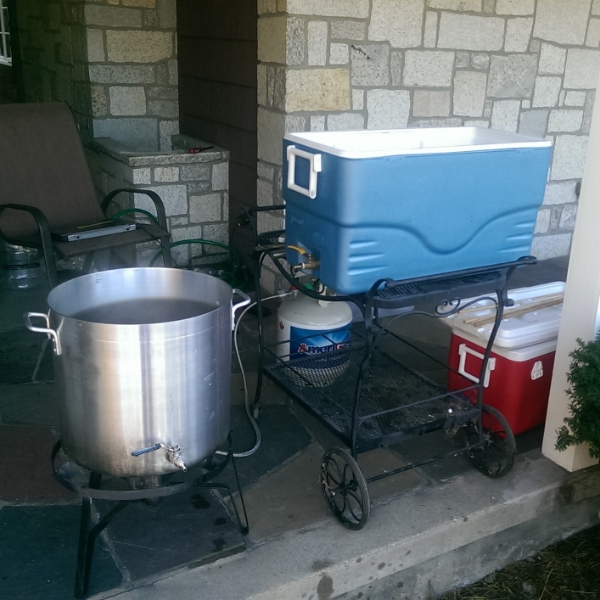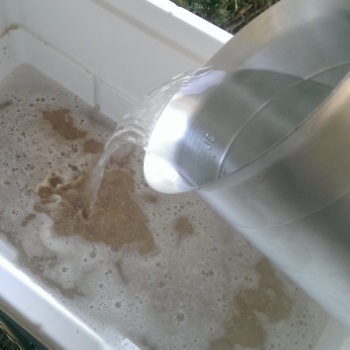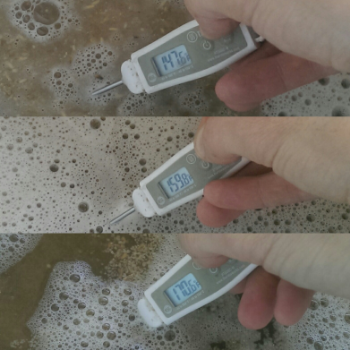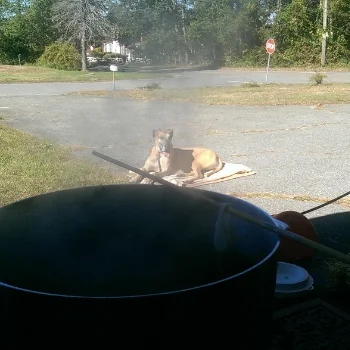Trappist (style) Single Ale
My abbey for the day.
Trappist Ales are Belgian in nature, which means they're full of yeast driven phenols and esters that cover a wide range of gravities and colors. They also have to be brewed in a specially designated Trappist monastery by monks to truly be "Trappist." Now I don't live in a monastery and I'm definitely not a monk, but that doesn't mean I can't brew the styles of beer that are brewed in world renowned monasteries and drink the beers like monks drink.
The Trappist single is one of the newer BJCP styles, but that doesn't mean it only came about recently. Traditionally the Trappist single was drank by the monks at the monastery; they'd sell their stronger Dubbels, Tripels, and Quads outside the Abbey walls because people would pay more money for the stronger beers. They're quite pale in nature, low in ABV, relatively hoppy, and have a solid malt presence with a light fruitiness (citrus, stone, or pome) and spice character (more clove like than pepper) from the yeast.
Recipe for 5.5 gallon batch of beer:
- 8lbs Belgian Pilsner Malt
- 1lb Pale 6-row Malt
- 0.75lbs Biscuit Malt
- 0.25lbs Honey Malt
Mash at 148F for 20 minutes, add boiling water to raise temp to 160F for 40 minutes, add boiling water to raise temp to 170F for 15 minutes. Boil for 90 minutes.
Boil Additions:
- 0.75 oz Perle first wort hopping @90 minutes
- 0.25 oz Perle @30 minutes
- 0.4 oz Perle and 0.5 oz Saaz @15 minutes
- Irish Moss @15 minutes
- 0.6 oz Perle and 0.5 oz Saaz @5 minutes
Fermentation Plan:
- White Labs WLP500 - Trappist Ale
- Pitch at 62F and every 24 hours raise temperature 1F until you hit 70F. Keep at 70F for a week
The grain bill is built off of the 2015 BJCP style guide for the Trappist single, where they mention that notes of biscuit and honey can be present, the 6-row addition comes from what Spencer Brewery does (the only Trappist Brewery in America that's right here in Massachusetts) it should help thin out the beer and give a complimentary grain flavor to the Pilsner malt. I went traditional with the hops, using Perle and Saaz, which will help boost the fruit and spice notes. For yeast I went with WLP500, it is suppose to give a mild earthy/spice presence when started low and then I wanted to slowly ramp up the temp just to 70 and let it sit there to give some fruity esters time to develop, but not too much of either as to overpower the malts and hops.
Stepping on up to the next temp.
The mash schedule is something I do a lot with my German style beers, doing the two step infusion mash at a lower and higher temp gives both beta and alpha amylase a chance to do their thing without the other mucking things up for them. In the mid 140s, beta rules the day while alpha is barely active, making simple sugars. Around 160F, alpha becomes active and beta will denature, allowing the rest of the converted starches to be longer and more complex. This gives you a lot of very simple sugars that ferment completely out, but also more complex sugars that will give your beer a bit of body, flavor, and sweetness. Since I mash in a a simple cooler and don't have any fancy heating circulation setup, I have to add boiling water to hit my target temps. Luckily BeerSmith does a great job with these calculations, allowing me to hit the temps with ease.
3 for 3, always a good day.
While I had no hitches on brew day, getting my starter going and beer fermenting was a different story. I had a fresh vial of yeast, made 1L of 1.040 starting wort, pitched the yeast, and then didn't really see signs of fermentation after 24 hours. The solution definitely got more turbid and it smelled like it was doing something, but there was no krausen and I couldn't really see any CO2 bubbles working their way to the surface. So, after the wort cooled down to 62F, I pitched anyways assuming everything fermented out in the starter overnight and I just missed it. I should have just let the wort sit in my fermentation chamber for another 12-24 hours and let the starter go longer because my kitchen was quite cool, but I didn't because, hey...what's the worst that could happen?
Those bricks are patent pending proprietary property of Wild Science Brewing Company.
Day 1 at 62F: No signs of fermentation, no big deal, it's a little cool for Belgian yeast, I'll see something tomorrow. Swirled the carboy to rouse up the yeast.
Day 2 at 63F: No signs of fermentation, ok, this is weird, I've never had a beer not show signs of fermentation after 48 hours, even lagers at 50F. Swirled the carboy again to rouse up the yeast.
Day 3 at 64F: No signs of fermentation, how the hell did I kill my yeast? Should I go run and pick some more up? Hey at least this tells me my technique is good and I don't have any infection after 72 hours, got to find that silver lining. Swirl it!
Day 4 at 65F: Giant krausen about 5 hours after increasing temp. Relief...but what if it's just all wild yeast and bacteria finally taking off? I'll just turn it into a wild ale, it'll still be beer and it may even be good.
Day 5 at 66F: Activity already slowing, grabbed a quick sample just to make myself feel better. No sourness, good flavor already, guess I made beer.
After finishing the ramp up to 70F and letting it sit there for 1 week, I bottled 1 gallon of it to 3.3 volumes of CO2 in thick walled 12oz bottles. My local homebrew club is having a competition with this style in November and I wanted to make sure my beer would be carbed to style guideline. The rest of the beer was kegged and carbed.
It doesn't quite have the fruit esters I wanted, but the spice notes from the phenols are spot on. I was really glad to not have bubblegum notes, I was worried that the yeast could have been stressed from the long lag time and would give me a bubblegum bomb. The bitterness and flavors from the hops are great, I think adding a late charge of either Mandarina Bavaria or Haulertau Blanc would be an interesting way to get some more fruit notes in there without having to fuss with yeast temps. The FG was higher than I would have expected, but the beer definitely doesn't come across as sweet and finishes quite dry. I imagine that a bigger/healthier starter would have chewed through more sugars to finish a few points lower. When I brew this again, I'll start at 64F and ramp up to the mid 70s, with a starter I'm more confident in. I've since read that WLP500 can be a bit fickle at lower temps, and I'm guessing that's what I saw with both my starter and beer.
Overall, I really like this beer, it goes down easy, tantalizes the taste buds into wanting more, and as it warms to room temp, you get to taste new layers of flavor.
Enjoy it while you can, Spock, winter is coming.
Final numbers for my Trappist Single:
- Batch Size: 5.5 gallons
- Original Gravity: 1.048
- Final Gravity: 1.012
- ABV: 4.7%
- IBU: 43




